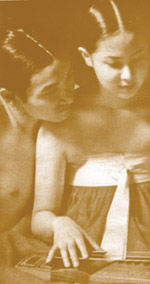Valuable work on Korean cinema
R. S. Godage
This book is about on Korean cinema. The first half of the book has
been dedicated to discuss the history of Korean cinema, where the book
gives a general background about Korean cinema since 1903 up to 1980. In
this chapter the author has discussed - how motion picture arrived
colonized Korea (the origin); The exhibition of moving pictures and the
advent of Korean cinema (such as Park Jung - hyun’s interference by
making The story of Jang-hwa and Hong Ryeon in 1924); Japanese colonial
period and heyday of silent films; conflict between colonialism and
nationalism; Motion picture and film censorship regulation; Arirang and
 national
cinema; The KAPE cinema movement and left wing films; The sound film and
militarism; national
cinema; The KAPE cinema movement and left wing films; The sound film and
militarism;
The first Korean sound film (The Story of Chun-hyang in 1930); The
motion picture law; Liberation and the Korean war as a one of the main
components of Korean cinema; Polices to promote the film industry after
the Korean war; The Korean cinema renaissance in 1960s; The
authoritarian period and depression of the film industry; The formation
of the teen audience for high teen films. The second half of the book
presents a detailed analysis of modern Korean cinema since 1980s up to
now. It includes the following essays: The pressure group of Korean
cinema; Liberation of production and foreign film imports; Film
education in Korea (such as The Korean Academy of Film Art); The
beginning of Hollywood direct distribution and resistance; The
small-scale theatre culture and the popularization of videos;
The new Korean cinema movements; The development of alternative and
independent films; Changes in the Korean film industry after direct
distribution; The advent of Korean new wave (along with Park Kwang-su);
Sopyonje, Im Kwon-taek and the revival of nationalism (in 1993); Art
film exhibition: from videoteques to Art film theatre; Defend the screen
quota system; The enactment of the film promotion law and the launch of
the Korean film council; The growth and outlook of Korea cinema since
1996 (growth in quantity and growth in quality); The launch of film
festivals (such as Pusan, Puchon, Jeonju, Seoul etc); Multiplex theatre
system.
The third half of the book includes an in-depth critical analysis on
Kim Ki-duk’s film language which will focus on: The biography of Kim
Ki-duk; His way of using of film langauge; Avant-garde attribution of
Kim Ki-duk in making films; Analytical essays on films text of Kim Ki -
such as Bad guy, Spring, Summer, Fall, Winter... and Spring, Samaritan
Girl and 3-Iron. The author of this work is a Postgraduate (MA) of
Kelaniya university (Sri Lanka) Graduate (BA) of Sri Jayawrdenepura
University (Sri Lanka), a Diploma holder in Cinematography, a
Certificate holder in filmmaking from South Korea (Asian Young
Filmmakers Forum - 2007/0), a Certificate holder in Korean language from
Chonbuck National University Korea and a fellow of Asian Film Academy (AFA
2009) Korea. |



